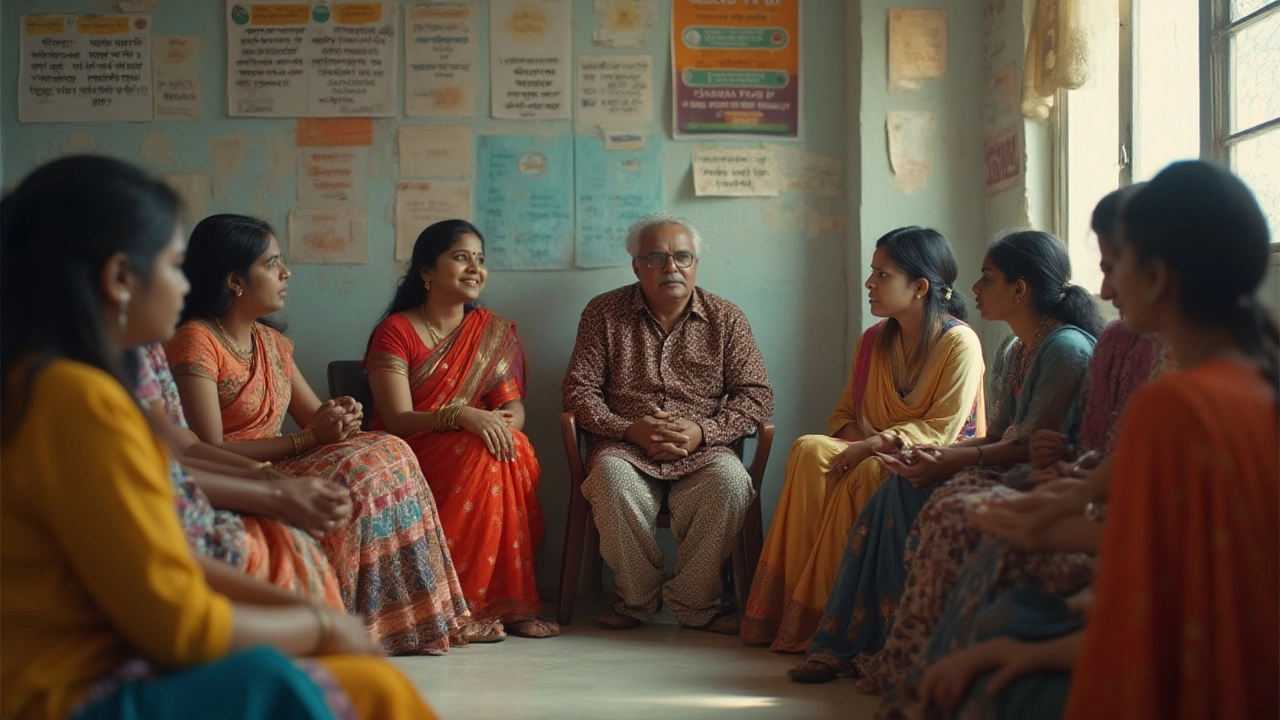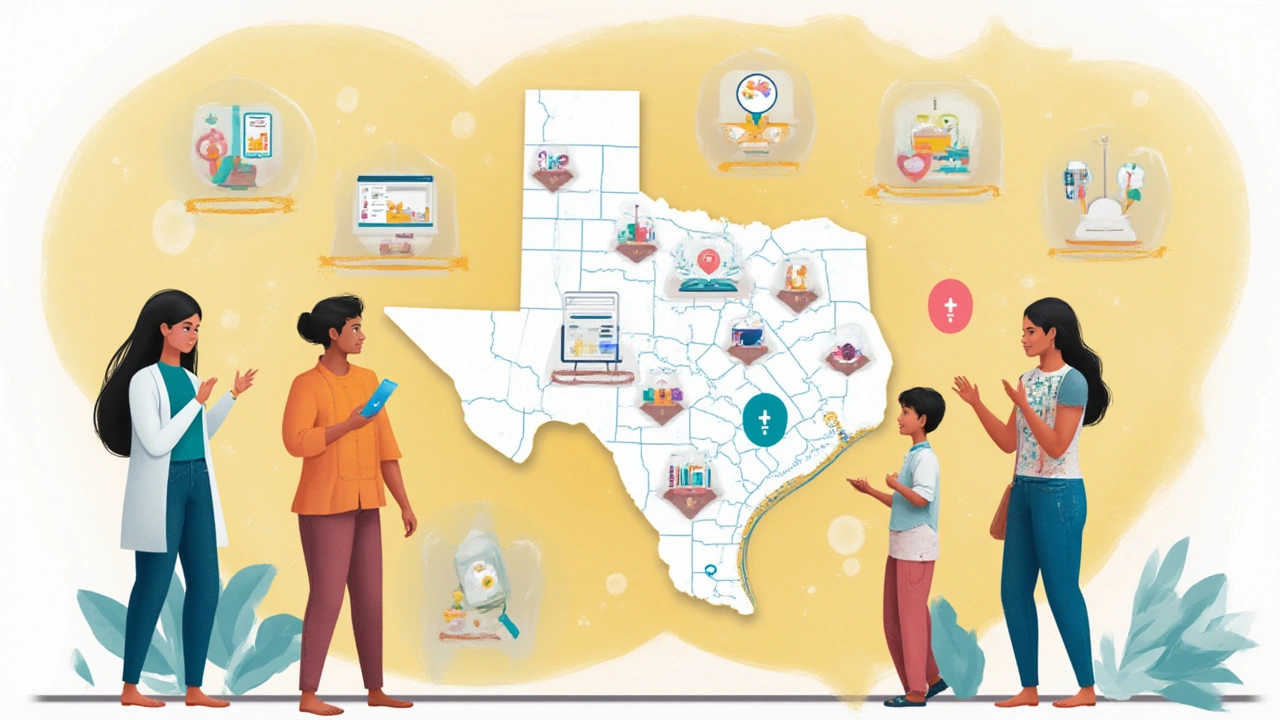Texas Mental Health Help: How the Lone Star State Ranks in 2025
 Jul, 14 2025
Jul, 14 2025
Picture this: In a state as huge and bold as Texas, your neighbor could be doing fine—or silently falling through cracks in a mental health system that’s stretched thin. Millions of Texans wake up every day facing their own mental health battles, but not everyone gets the help they need. The numbers tell a story that’s hard to ignore, and when it comes to offering mental health support, Texas often surprises people with where it stands.
How Does Texas Measure Up in Mental Health Support?
Texas, with its booming cities and wide stretches of rural land, ends up almost in the middle of the pack when you compare mental health care by state—but not in ways you might hope. According to Mental Health America’s 2024 annual report, Texas ranked 43rd out of 51 (including Washington D.C.) for overall access to mental health care. Doesn’t sound great, right? Digging deeper, the state falls behind the national average for several major markers. If you look at the percentage of adults with any mental illness who didn’t receive treatment in the past year, Texas is right at the top of that list, coming in at an unsettling 61%—that’s nearly two out of every three adults not getting help.
So why is Texas lagging? First off, the funding levels just aren’t there. The Kaiser Family Foundation’s most recent data says Texas spends just $40 per person on mental health services from state agencies. Compare that to states like New York, which spends more than double per resident. With over 30 million people calling Texas home, this gap becomes pretty stark.
Access isn’t just a problem for adults. For children and teens, it’s even tougher. Studies from the Texas Pediatric Society highlight that nearly 70% of youth who experience depression or anxiety don’t get the support they need. That’s a lot of young people facing tough battles alone.
If you’re in a rural town, the hurdle gets higher. More than 185 Texas counties don’t have a single licensed psychiatrist. Imagine needing to drive hours just for a consultation. Telehealth options have helped a little, but internet service outside of metro areas isn’t always reliable.
| Ranking Category | Texas Rank | National Average |
|---|---|---|
| Adults with Mental Illness Unmet Need (%) | 61% | 56% |
| Mental Health Funding per Capita | $40 | $121 |
| Number of Psychiatrists per 100,000 | 5.2 | 12.9 |
| Children with Depression Not Receiving Treatment (%) | 70% | 59% |
But here’s a twist: Texas does excel in one area—community spirit. Nonprofits, churches, and local groups try to fill some of these gaps. Still, the ranking numbers don’t lie. Texas tends to score poorly for access, availability, and funding, and those stubborn problems show up everywhere from crowded urban clinics to isolated ranches.
Why Is Mental Health Care in Texas So Challenging?
It’s easy to point fingers at funding, but the challenges go deeper. Texas faces a mix of old school ideas and new population booms. First, there’s stigma. In certain Texas communities, even talking about mental health is tough—some folks see it as weakness or something you fix yourself. This attitude means fewer people reach out even when services exist.
Next, good luck finding a provider—especially outside the big cities. Texas ranks among the lowest in provider availability, with five psychiatrists per 100,000 people. Compare that to Massachusetts, which has over four times that number. This shortage isn’t just about shrinks, either. There aren’t enough counselors, social workers, or school psychologists to meet the demand.
Insurance plays a big part. Texas has one of the highest uninsured rates in the US, around 16%. Many Texans don’t have plans that cover outpatient therapy or psychiatric meds. Medicaid expansion? Texas never signed on. So, low-income families often have to rely on patchy, underfunded public clinics or pay out of pocket—which is just not an option for some.
Another obstacle is getting care to fit today’s needs. A recent UT-Austin report showed that while demand for therapy and crisis support has gone up sharply since the pandemic, hiring and keeping mental health professionals is slow business. Burnout is real. Jobs pay less than similar health fields, so workers jump ship or leave the state.
Then there’s red tape—like months-long waitlists, tough paperwork, and strict rules over who qualifies for public help. For those who struggle with transportation or unreliable work schedules, just making it to an appointment can mean missing a paycheck.
Recent efforts have included new state funding boosts and partnerships with colleges to train more mental health workers, but those don’t fix things overnight. In short: Too many people, too few professionals, not enough money, and a deeply rooted sense that talking about mental health is still a little bit hush-hush.

Resources and Strategies: What’s Available in Texas?
Here’s the good news—help is out there, even if the road is bumpy. Texas has 39 local mental health authorities, each covering a chunk of the state. These public clinics offer sliding scale fees and crisis support, though wait times can stretch for weeks, especially for ongoing therapy.
For urgent situations, the Texas Suicide and Crisis Lifeline (988) gives free, confidential support 24/7. More hospitals and counties now have mobile crisis teams, so if someone’s in a tough spot, trained people can come to them, not just the ER. Texas Child Health Access Through Telemedicine (TCHATT) lets school counselors connect students to remote therapy, which is handy in districts without their own psychologists.
If you’re a parent or adult looking for affordable care, the National Alliance on Mental Illness (NAMI) Texas offers support groups, online classes, and advocacy help—all at no cost. Some churches and community centers are stepping up with safe spaces for group chats or “mental wellness” events that don’t feel medical, but still make a difference.
Here’s a tip: If you have insurance, call and ask for a list of in-network therapists—they often know who accepts new patients. No coverage? Many therapists now offer low-fee slots for people hit by hardship; you just have to ask. Psychology Today’s online directory lists professionals by location, cost, and specialty, which makes searching less frustrating. And remember, sometimes you’ve got to try a few before finding the right fit—it’s not one-size-fits-all.
- Use telehealth services: More Texas therapists now offer video or phone sessions.
- Ask about virtual support groups: These have popped up statewide, even in small communities.
- Check local colleges: University psychology departments sometimes offer lower-cost counseling with grad students, supervised by licensed pros.
- If you’re a veteran, check with the VA or Texas Veterans Commission for dedicated mental health services.
- For Spanish-speaking Texans, local Hispanic community associations often have bilingual counselors or know who does.
Don’t underestimate apps, either. Tools like Calm, Headspace, and Moodfit can help you track moods, learn coping skills, and get guided meditations—handy if you’re waiting for an in-person therapist or just need a boost.
What Needs to Change—and How Can Texans Advocate?
Here in July 2025, people aren’t just sitting back. From legislative meetings in Austin to school board gatherings in tiny Panhandle towns, Texans are pushing for real change in mental health care—and results are starting to show, slowly.
Lawmakers bumped the state mental health budget by 9% last year, directing funds toward building up crisis centers and hiring more professionals in rural counties. Some school districts have new rules requiring annual mental health screenings for students—a first for Texas—and more training for teachers on spotting warning signs.
Everyday people are getting louder, too. It turns out, Texans aren’t shy when it comes to advocacy. If you want to help, here’s what works:
- Contact your local state representative: Real stories matter. Legislators say firsthand accounts push them to act quicker than stats ever could.
- Sign up for a NAMI Texas advocacy team or attend community-wide mental health events; lawmakers often show up and listen.
- Share resources with friends, family, and neighbors. Sometimes folks don’t even know help exists.
- Support nonprofits and school-based programs; these groups rely on donations and word of mouth.
- Push for insurance coverage: Ask your employer about mental health benefits. More demand means more companies upgrading their plans.
For anyone struggling, the most important thing is to keep reaching out. Texas has a long way to go, but the tide is slowly turning thanks to persistent people—moms sharing on Facebook, teachers raising issues at PTA, brave teens posting stories on TikTok.
At the end of the day, what really stands out is the human side—how people take care of each other, how neighbors try to patch up what the big system misses, and how each small effort chips away at the old stigma. And while Texas still finds itself near the bottom in most national rankings, a fierce, stubborn hope ties the story together: Things can—and should—get better, but only if we all keep pushing.